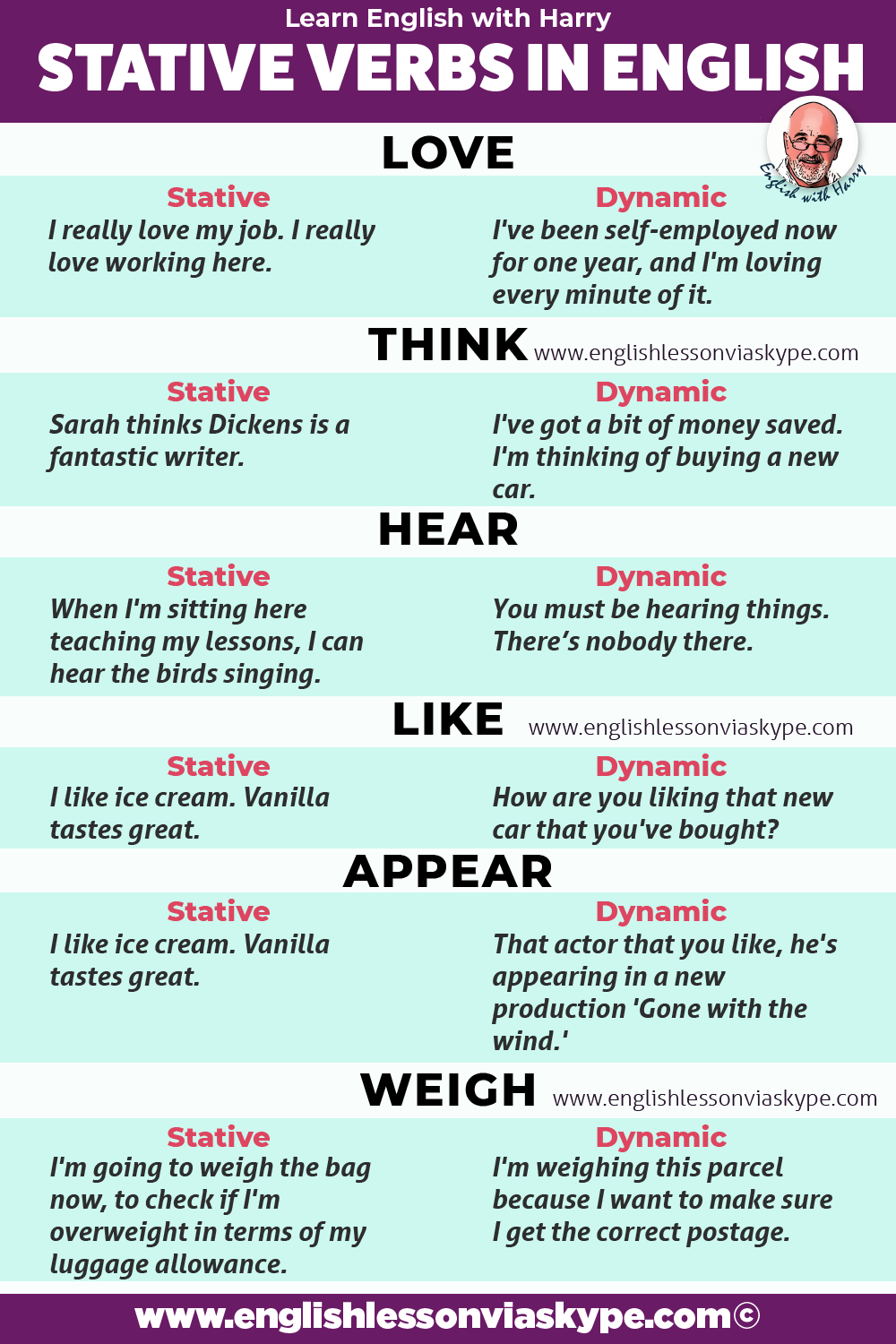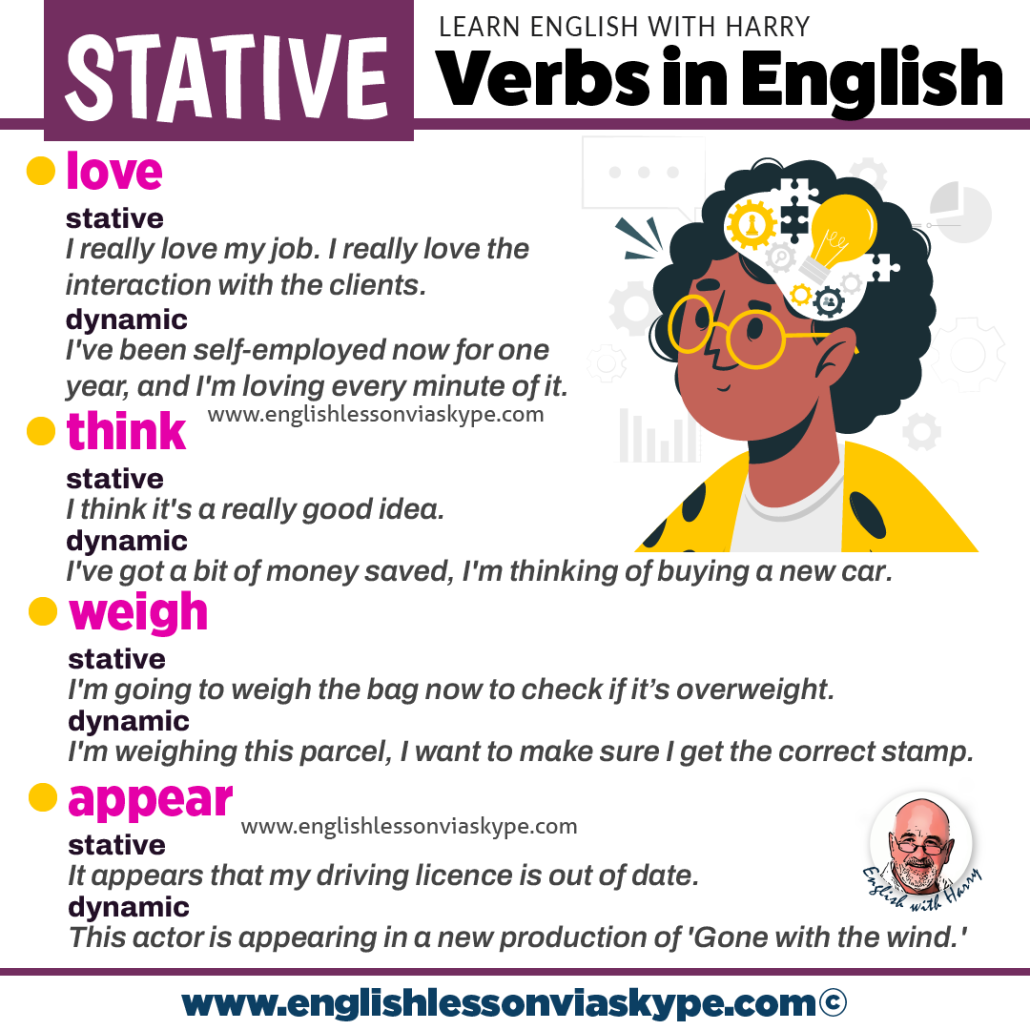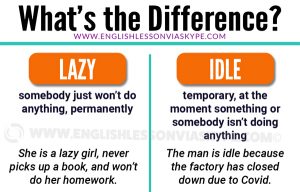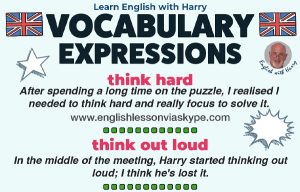Stative verbs in continuous form
Harry
How to use Stative Verbs in English
Hi there, welcome back teacher Harry here back to our English lessons where I try to give you a better understanding and help you to improve your English. Whether it’s for business English or just ordinary conversational English with your friends.
In this lesson, we’re going to talk about stative verbs in English. Stative verbs fall into 4 key categories:
- Verbs showing thought or opinions – think, believe, know
- Verbs showing possession – have, own, possess
- Verbs showing senses – hear, smell, taste
- Verbs showing emotion – love, like, hate
And normally, when we use these stative verbs in English, we use them in the simple tense. We seldom use them in the continuous format or -ing as some people refer to it. But we can. And there are exceptions.
So I’ll give you the stative verbs. I’ll give you examples of them in their simple format. And then I’ll also give you examples when you can use them in that continuous form.
Intermediate to Advanced English Marathon

INSANITY: doing the same thing over and over again and expecting different results.
Albert Einstein
- What you'll learn:
- better understanding of more complex grammar structures
- advanced English vocabulary words
- British & American slang
- perfect your listening skills through practing different accents
- This marathon is for you if you're:
- stuck at an intermediate English level
- tired of confusing explanations
- a mature student
- shy & introverted
love
Stative
So if somebody is talking about their job, they could say,
I really love my job. I really love working here. I really love the interaction with the clients.
So it’s a very, very standard way of describing your job.
Dynamic
But you could also use it in a more dynamic way where you could say,
I’ve been self-employed now for one year, and I’m loving every minute of it.
So we’re talking there, and something continuous. It’s a good example of using love in a more dynamic way.
I’ve moved from where a school in the suburbs to an inner-city school. I’m loving every day that I go to school.
think
Stative
I think it’s a really good idea.
She thinks he is a fantastic writer.
Okay, talking about perhaps Dickens.
Dynamic
But if we want to use think in another way, we can say something like,
Yeah, I’ve got a bit of money saved because of the COVID situation. I’m thinking of buying a new car.
I’m thinking of investing in an apartment. So it’s about time I moved away from mum and dad.
So I’m thinking of this, or I’m thinking about that. So it’s something you’re planning, something you’re looking at. It’s not something you’ve decided on yet.
It’s a really good example of using those stative verbs in a more dynamic way.
book your trial English Lesson
hear
Stative
When I’m sitting here teaching my lessons, I can hear the birds singing.
Early in the morning, I hear the birds in the trees.
Dynamic
If I want to use it in a more dynamic way, we could say something
👩🦱 Did you hear a knock on the door?
👩🦰 No, I didn’t hear anything. I think you must be hearing things.
like
Stative
I like ice cream. Vanilla tastes great.
Dynamic
In the same way, we can use it more dynamic way when somebody is talking to their friend,
Oh, I hear you’ve moved jobs recently. Are you liking the experience?
How are you liking the move to the new city?
How are you liking that new car that you’ve bought?
How To Use Stative Verbs In English

Share and help other students to improve English language skills.
appear
Stative
You look at your driving licence,
It appears that my driving licence is out of date, I will have to apply for a new one.
It appears as if the trains are on strike, we’ll have to get a bus.
Dynamic
If you want to use it somewhat more dynamic then you could say,
Oh, that actor that you like, he’s appearing in a new production ‘Gone with the wind.’ Would you like to go?
So the actor or actress they are appearing in a new production on stage. So again, a little bit more dynamic.
weigh
Stative
That’s W-E-I-G-H.
I’m going to weigh the bag now, to check if I’m overweight in terms of my luggage allowance.
Dynamic
Or we can be a bit more dynamic.
I’m weighing this parcel before I go to the post office because I want to make sure I get the correct stamp.
Speak better English with Harry - Episode 354
wish
Stative
We often sit on Tuesday or Wednesday or Thursday afternoon and think,
I wish it was the weekend. I wish work would be over. I wish it was five o’clock.
Dynamic
And then a more dynamic way we somebody can ask,
What are you wishing for for the new year?
What are you wishing for for your birthday?
Is there some special gift you are wishing for?
So these are all good examples of how to use stative verbs in English.
How To Use Stative Verbs In English

Now, there are certain verbs that you can use in the simple format or you can use them with the -ing or the continuous format, and there is no difference in the meaning. Let me give you an example of those.
ache
So you’ve been working in the garden, and you’re getting ready for the spring, you can come home and say,
Oh, my back aches, my back aches. Stative
Oh, my back is really aching. Dynamic
The meaning is the same.
hurt
I was running in the park and I fell over a brick or a stick or on some pothole in the ground,
Oh, my foot hurts. Stative
Oh, my foot is hurting. Dynamic
feel
The classic one here was about feel. Somebody will ask you in the morning,
How do you feel? Stative
How are you feeling today? Dynamic
Exactly the same, the meaning is identical.
look
Your daughter is getting ready to go to her graduation ball and she’s bought a new dress and you turn to your husband and say,
Wow, she looks really good in that dress. Stative
She’s looking really good today. Dynamic
The meaning exactly the same.
Well, hopefully, you’ve enjoyed this particular lesson on how to use stative verbs in English. If you want to contact me, well, of course, you can do so on www.englishlessonviaskype.com.
Any comments that you have, I’m very happy to hear them. Thanks for listening. Join me again soon.
More information
For more information on English grammar rules, English collocations and English idioms, check out the links below:
English collocations related to health
English vocabulary related to problems and advice
You can always study English advanced level at Learning English with the BBC.
You will love these English lessons

Difference between Lazy and Idle
Here you will learn the difference between Lazy and Idle. You will also learn the meaning of an English expression


Natural English Collocations with Think
Learn natural English collocations. Are you eager to sound more like a native speaker and less like a textbook? Today,


Interesting Phrasal Verbs
Here you will learn interesting phrasal verbs. I’ve taken them randomly, they’re not very normal phrasal verbs. So hopefully you’ll